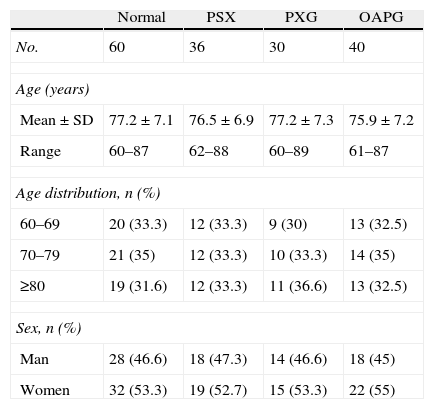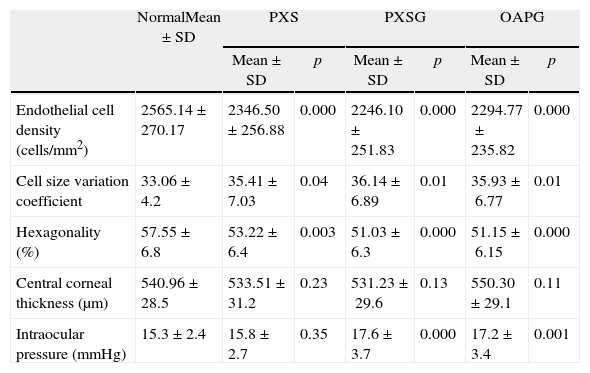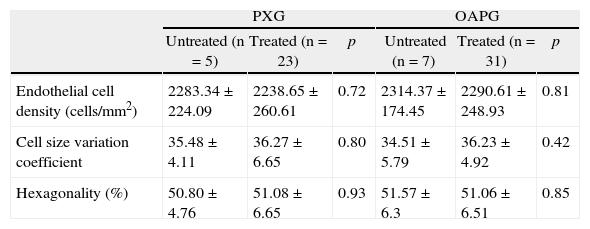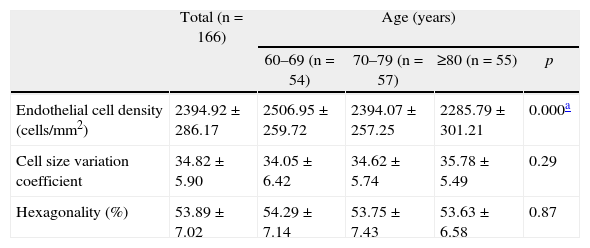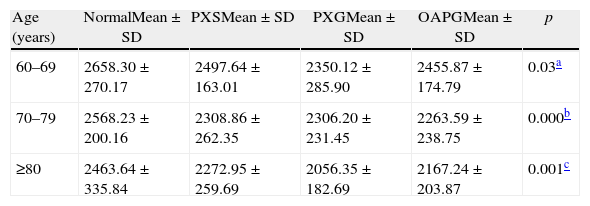To evaluate the corneal endothelial morphometry and central corneal thickness (CCT) in pseudoexfoliative (PEX) eyes with and without glaucoma and to compare with normal eyes and eyes with primary open-angle glaucoma (POAG).
MethodA total of 166 patients were included in this study: 36 eyes with pseudoexfoliation syndrome (PXS), 30 eyes with pseudoexfoliation glaucoma (PXG), 40 eyes with POAG, and 60 normal eyes. Corneal endothelial cell density (ECD), coefficient of variation (CV) in cell size, and percentage of hexagonal cells were measured using a non-contact specular microscope, whereas CCT was measured with an ultrasonic pachymeter.
ResultsECD and percentage of hexagonal cells were lower in PEX groups and in the POAG group compared with normal eyes, while the CV in cell size was greater. There was a tendency for greater cell loss and morphological abnormalities of the corneal endothelial cells in PXG eyes compared to PXS eyes, when all pseudoexfoliative eyes were analyzed together. Changes in endothelial cells increased with age. There were no significant differences in mean CCT between the four groups.
ConclusionEndothelial cell density is significantly decreased, and pleomorphism and polymegathism of cells are increased in PEX eyes, particularly when intraocular pressure is high.
Analizar el patrón morfométrico de las células endoteliales de la córnea y el espesor corneal central (ECC) en los ojos con pseudoexfoliativo (PEX) con y sin glaucoma, y compararlos con ojos normales y con glaucoma primario de ángulo abierto (GPAA).
MétodoSe incluyeron 166 pacientes en el estudio: 36 sujetos con síndrome seudoexfoliativo, 30 con glaucoma seudoexfoliativo (GPEX), 40 con GPAA y 60 pacientes normales. Los parámetros evaluados con el microscopio especular de no contacto fueron la densidad de células endoteliales (DCE), el coeficiente de variación (CV) del tamaño celular y el porcentaje de hexagonalidad. El ECC se midió con paquimetría de contacto.
ResultadosLa DCE y el porcentaje de hexagonalidad celular fueron menores en los sujetos con PEX y GPAA respecto al grupo control, mientras que el CV del tamaño celular fue mayor. Considerando los 2 grupos de ojos con PEX, se observó una tendencia hacia una mayor pérdida de células endoteliales y de modificaciones en los parámetros morfométricos en los ojos con GPEX. Las alteraciones en el patrón especular aumentaron progresivamente con la edad. No hubo diferencias significativas en el valor medio de ECC entre los 4 grupos.
ConclusiónLa densidad de células endoteliales está significativamente disminuida y el pleomorfismo y polimegatismo celular incrementado en los ojos con PEX, especialmente cuando la presión intraocular es alta.





